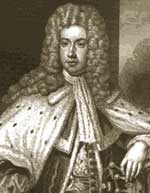James Radcliffe

3. jarl af Derwentwater. Engelsk jakobit-oprører. Henrettet i 1716 efter nederlaget ved Preston.
- Preston II, 1715
From an old Roman Catholic family, with their seat at Dilston in Northumberland, James Radcliffe was the eldest son of Lady Mary Tudor, an illegitimate daughter of Charles ll, and Edward Radcliffe, 2nd Earl of Derwentwater. At the age of thirteen he was sent to Saint-Germain at the request of Queen Mary, widow of James ll, to be a companion for the young Prince James Francis Edward. Here he was tutored at the Jesuit College of St Louis le Grand in Paris. Inheriting the Derwentwater estates in 1705, he returned to England four years later and took up residence at Dilston, becoming a prominent figure in Northern society and a focus for Jacobite support. He was noted for being a man of great charm and kindness, and was highly thought of by friends and tenants alike. In 1712 he married Anna Maria Webb, a Catholic heiress, and left Dilston for a period of two years to live at Hatherop in Gloucestershire, a property belonging to the family of his wife. During this time, the old manor house of the Radcliffes was being rebuilt and transformed into Dilston Hall, a grand and stately mansion, more befitting to the needs of the fashionable young Earl. Returning here with his wife and baby son, in July 1714, it was only one month before Queen Anne was dead and George of Hanover established on the English throne. Jacobite unrest broke out and gradually became widespread. By the following year plans to restore the exiled Stuarts by force of arms were well underway. The Earl was a key player in the 1715 rising in which he took an active part. After surrendering at Preston he was attainted and condemned to death. Attempts to win a reprieve were in vain and he was beheaded on Tower Hill on 24 February 1716. His remains were secretly conveyed north for burial in Dilston Chapel. As the cortege bearing his coffin reached the outskirts of Durham city, the skies were spectacularly lit up by a brilliant display of the aurora borealis (the Northern Lights). It was immediately rumoured that this was an omen of heaven's wrath at the death of the gentle and popular Earl. The lights were afterwards known in the north of England as Lord Derwentwater's Lights. With this superstition the Derwentwater legend was born, and the dramatic and tragic events of the Earl's short life were soon firmly entrenched in Northumbrian folklore.